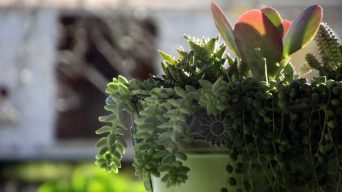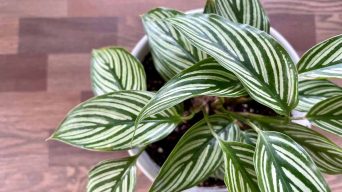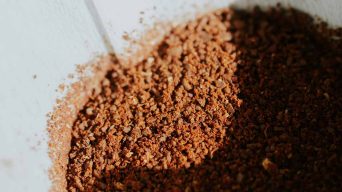Coffee grounds can be beneficial for Monstera plants if used in moderation and with caution. They provide nutrients and improve soil structure but can also promote fungal growth and attract fungus gnats. Using coffee grounds as a slow-release fertilizer in a small cloth bag buried near the pot’s side is recommended.
If you’re a Monstera lover, then you may have heard that adding coffee grounds to your plant’s soil can be beneficial.
While this is true in some cases, it’s important to understand the pros and cons of using coffee grounds as well as how to use them safely.
Coffee grounds can provide nutrients, improve soil structure, and even deter pests – but they must be used correctly to avoid potentially damaging effects such as fungal growth or attracting fungus gnats.
In this article, we’ll explore the different ways that coffee grounds can help (or hurt) your Monstera plant.
Benefits of Using Coffee Grounds for Monstera Plants
If you’re a plant lover, you might have heard about using coffee grounds as a natural fertilizer for your indoor plants.
But are coffee grounds good for Monstera plants?
The answer is yes! Coffee grounds can provide many benefits to Monstera plants, including nutrient content, soil structure improvement, and moisture retention properties.
1. Nutrient Content
Coffee grounds are rich in nutrients that are essential for plant growth, such as nitrogen, phosphorus, and potassium.
These nutrients help to promote healthy foliage growth and improve the overall health of the plant.
Monstera plants require a balanced supply of these nutrients to thrive, making coffee grounds an excellent natural fertilizer option.
2. Soil Structure Improvement
Coffee grounds also contain minerals like magnesium and calcium that help to improve soil structure.
When added to the soil, coffee grounds can help to loosen compacted soil and improve drainage.
This allows air and water to circulate freely around the roots of the Monstera plant, promoting healthy root growth.
3. Moisture Retention Properties
Another benefit of using coffee grounds for Monstera plants is their ability to retain moisture in the soil.
Coffee grounds act as a sponge, absorbing excess water and releasing it slowly over time.
This helps to prevent overwatering and ensures that the plant has a steady supply of moisture.
4. Pest Deterrent
Finally, coffee grounds can also act as a natural deterrent for pests like slugs and snails.
The sharp particles in the grounds irritate these critters and keep them away from your Monstera plant.
This can be especially helpful if you’re dealing with an infestation of garden pests.
When using coffee grounds as a fertilizer for your Monstera plant, it’s important to keep in mind that they should be used in moderation.
Too much coffee grounds can be damaging to the plant, as an excess of minerals and nutrients can lead to fungal growth or attract fungus gnats.
It’s best to start with a small amount and gradually increase it over time if needed.
Coffee grounds are an excellent natural fertilizer option for Monstera plants due to their nutrient content, soil structure improvement properties, and moisture retention abilities.
By using them properly and in moderation, you can give your Monstera plant all the nutrients it needs to thrive while also reducing waste by repurposing used coffee grounds.
Risks of Using Coffee Grounds for Monstera Plants
Coffee grounds have been touted as a natural fertilizer for plants, including Monstera.
However, before you start sprinkling coffee grounds on your Monstera plant, it’s important to consider the potential risks.
1. Promoting Fungal Growth
One of the biggest risks of using coffee grounds on Monstera plants is that they can promote fungal growth.
Coffee grounds are high in nitrogen, which can encourage the growth of fungi in soil. This can lead to root rot and other fungal diseases that could damage your Monstera plant.
To avoid promoting fungal growth, it’s best to use coffee grounds sparingly and mix them with other organic materials like compost or leaf mold.
This will help balance the nitrogen content in the soil and reduce the risk of fungal growth.
2. Attracting Fungus Gnats
Another risk of using coffee grounds on Monstera plants is that they can attract fungus gnats.
These small insects are attracted to moist soil and decaying organic matter, such as coffee grounds.
If you use too many coffee grounds or apply them directly to the soil surface, you may create an environment that is attractive to fungus gnats. This can lead to an infestation that can harm your Monstera plant.
To avoid attracting fungus gnats, it’s best to mix coffee grounds with other organic materials and bury them in the soil rather than applying them directly on top.
3. Minimal Effect on Soil pH
Contrary to popular belief, using coffee grounds on Monstera plants has minimal effect on soil pH. While coffee is acidic, most of the acid is removed during brewing.
Studies have shown that adding coffee grounds to soil has little effect on pH levels over time.
Therefore, if you’re hoping to lower the pH of your Monstera soil, using coffee grounds may not be an effective method.
4. Maintaining Balance
Finally, it’s important to remember that when using coffee grounds as a fertilizer for Monstera plants, you need to maintain balance.
Coffee grounds are high in nitrogen and calcium, but they don’t contain other essential plant nutrients like phosphorus or potassium.
You should supplement the coffee grounds with other organic materials to make sure your Monstera plant is getting all the nutrients it needs.
While there are some benefits to using coffee grounds as a natural fertilizer for plants like Monstera, there are also potential risks that should be considered.
To avoid promoting fungal growth and attracting fungus gnats, it’s best to use coffee grounds sparingly and mix them with other organic materials before burying them in the soil.
And if you’re hoping to lower your Monstera plant’s soil pH, there may be more effective methods than using coffee grounds alone.
Preparing Coffee Grounds for Use in Monstera Plants
If you decide to use coffee grounds as a fertilizer for your Monstera plant, there are some steps you can take to prepare them.
1. Collection and Storage
First and foremost, only use freshly-brewed coffee grounds that haven’t been sitting out too long.
Old or stale coffee grounds can contain harmful bacteria that can be detrimental to your Monstera plant.
Once you’ve collected your coffee grounds, it’s important to store them properly.
Coffee grounds should be stored in an airtight container and kept in a cool, dark place until they are ready to be used.
Storing them this way helps prevent the growth of bacteria and mold that can harm your Monstera plant.
2. Dilution
When using coffee grounds on Monstera plants, it’s important to dilute them first. This will help reduce the risk of fungal growth and other issues.
To dilute coffee grounds, mix them with equal parts compost or other organic material. This will help create a balanced fertilizer that won’t overwhelm your Monstera plant’s soil.
3. Preparation
It’s also important to prepare the coffee grounds for use in Monstera plants before adding them to the soil.
To do this, you can steep the grounds in a compost tea or mix them with other organic materials like leaf mold.
This will help create an environment that’s beneficial to your Monstera plant and reduce the risk of fungal growth.
4. Use Dried Grounds
Finally, when using coffee grounds as a fertilizer for Monstera plants, it’s best to use dried grounds. Wet or damp grounds can attract fungus gnats and other pests that can harm your plant.
Therefore, it’s important to make sure the grounds are completely dry before adding them to the potting mix.
How To Use Coffee Grounds Safely for Monstera Plants
When used correctly, coffee grounds can be a great way to fertilize Monstera plants naturally.
Here are some tips on how to use coffee grounds safely for your Monstera plants:
1. Using Coffee Grounds as a Slow-Release Fertilizer
Coffee grounds contain nitrogen, phosphorus, potassium, and other micronutrients that can benefit your Monstera plant’s growth and health.
However, using fresh or undiluted coffee grounds directly on the soil can cause nutrient imbalances or root burn.
To avoid these issues, it’s best to use coffee grounds as a slow-release fertilizer by mixing them with compost or potting soil before adding them to your Monstera’s pot.
You can also sprinkle a thin layer of diluted coffee grounds on top of the potting mix once every few weeks.
2. Burying the Coffee Grounds in a Small Cloth Bag Near the Pot’s Side
Another way to use coffee grounds safely for your Monstera is by burying them in a small cloth bag near the pot’s side.
This method allows the nutrients from the coffee grounds to slowly release into the soil without affecting its pH levels or causing fungal growth.
To make a slow-release fertilizer bag with used coffee grounds, fill a small cloth bag with dry or slightly damp coffee grounds and tie it securely with string or rubber bands.
Then bury the bag about 2 inches deep near one side of your Monstera’s pot.
3. Using Coffee Grounds in Moderation
While coffee grounds can provide nutrients and improve soil structure for your Monstera plant, using too much of them can be harmful.
When using coffee grounds for your Monstera, it’s important to use them in moderation and not exceed the recommended amount.
For best results, mix a tablespoon of diluted coffee grounds with 1-2 cups of compost or potting soil mix before adding them to your Monstera’s pot.
You should also regularly monitor your plant’s growth and health and adjust your fertilization routine.
Using coffee grounds for Monstera plants can be beneficial if done correctly and in moderation. By following these tips on how to use them safely as fertilizer or slow-release bags, you can provide your beloved houseplant with extra nutrients while avoiding potential risks of fungal growth or nutrient imbalances.
Alternative Options for Fertilizing Monstera Plants
If you’re uncomfortable using coffee grounds for your Monstera, plenty of other alternatives can help your plant thrive.
1. Commercial Fertilizers
Commercial fertilizers are a popular option for many indoor gardeners as they provide a convenient and easy way to nourish your plants.
These fertilizers come in various forms, such as liquid, granular, or slow-release pellets.
They contain a balanced mix of essential nutrients such as nitrogen, phosphorus, and potassium, promoting healthy growth and development.
When choosing a commercial fertilizer for your Monstera plant, it is important to consider your plant’s specific needs.
For example, if your plant is young and still developing its root system, you may want to choose a fertilizer with higher levels of phosphorus to encourage root growth.
On the other hand, if your plant is mature and producing new leaves regularly, you may want to choose a fertilizer with higher levels of nitrogen to promote leaf growth.
2. Natural Fertilizers
If you prefer a more natural approach to fertilizing your Monstera plant, there are several options available that can provide the necessary nutrients without the use of synthetic chemicals.
- Compost: Composting is an excellent way to create nutrient-rich potting soil for your plants. You can create compost from kitchen scraps such as fruit and vegetable peels, eggshells, and coffee grounds (in moderation). Simply add these items to a compost bin or pile them along with yard waste, such as leaves and grass clippings. Over time, the organic matter will break down into rich soil that can be used to nourish your Monstera plant.
- Worm Casting: Worm castings are another natural fertilizer option that provides essential nutrients such as nitrogen and phosphorus in an easily absorbable form for plants. Worm castings are created by feeding organic matter such as food scraps or leaves to worms who then digest it and excrete nutrient-rich waste known as castings.
- Fish Emulsion: Fish emulsion is made from fish waste that has been broken down into liquid form through fermentation or enzymatic digestion processes. It contains high levels of nitrogen, which makes it an excellent choice for promoting leaf growth in Monstera plants.
3. Other Organic Matter
In addition to coffee grounds, several other types of organic matter can be used to nourish your Monstera plant.
- Epsom Salt: Epsom salt is a type of magnesium sulfate that can be added directly to the soil around your Monstera plant or dissolved in water and applied as a foliar spray. It promotes healthy growth by improving nutrient uptake in plants.
- Banana Peel: Banana peels contain high potassium levels, making them an excellent natural fertilizer option for promoting flower and fruit production in Monstera plants.
- Eggshells: Eggshells contain calcium which helps strengthen cell walls in plants and promotes healthy growth overall.
Using coffee grounds on Monstera plants can help them, but other things work better. They don’t have a chance to get fungus or bring in gnats like coffee grounds do.
Whether you choose commercial fertilizers or natural options like composting or worm castings – there’s no shortage of ways you can keep your indoor garden thriving!
With a little bit of research and experimentation, you’re sure to find the perfect fertilizer for your Monstera plant.
Final Thoughts
Though the jury is still out on whether or not coffee grounds are an effective fertilizer for monstera, it’s worth giving them a try.
If you’re looking for ways to reuse your spent coffee grounds, why not give it a shot? You may be pleasantly surprised by the results.
Just remember to use it in moderation and keep the concentration light – you don’t want to over-fertilize your plants.
Achieving a flourishing and robust monstera is easily attainable with the perfect blend of attention and a good dose of coffee!
At the end of the day, it’s important to experiment and find what works best for your particular plant. Every environment is different, so there’s no one-size-fits-all solution.
So don’t be afraid to experiment – who knows? You may have just stumbled upon a great new way to fertilize your plants!







